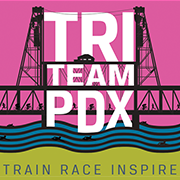Hello TTPDX teammates! Thank you for inviting me to coach your Track Workouts this season and for trusting me with your training. It’s an honor and a pleasure to work with you all.
As we are easing into springtime and many of us are emerging from a nice, long hibernation, I thought it might be a good time to review a bit of running lingo and clear up some questions about training paces.
Because not all of us are training to race, using terms like 5k pace or half marathon pace doesn’t always jive. Most of us understand that running at just one pace will only get us so far whether your goal is getting faster or getting fitter. It can also get pretty boring. Varying the pace of your runs enables you to better shape your training to meet your specific goals. It also keeps your body guessing and therefore continuing to change and adapt.
There are actually a few ways to measure your pace. Obviously, you can use a watch that tells you exactly how fast you’re running but that’s not the only way. You can use a heart-rate monitor and vary paces based on those numbers relative to your heart-rate max. Or, more simply, you can learn how your body feels at various training paces and use what’s called your RPE or Rate of Perceived Exertion, effort levels 1-10 (1 being super easy to 10 being all out) to build your training plan. Below I’m going to try and pull together some info that might be helpful. If you’re coached by me you know I sometimes use different words to describe the same thing. Hopefully, this will provide some help with translation. 🙂
I’m looking forward to the upcoming months of running together and hope to provide coaching that educates, inspires and supports you. Please never hesitate to reach out to me with questions or just to chat. I love talking about tri-training!
Happy running,
Remy
Easy Pace Run/Easy Aerobic Run/Recovery Run
Slower than marathon pace. You could run at this pace for hours (if you had to!)
RPE 1-3/10 It should feel pretty “comfortable” or as you might hear me say “easy peasy”.
Running at this pace is perfect for warm ups and cool downs. It also improves your overall aerobic fitness because you can theoretically log more miles. It can also help your body recover from a previous more challenging session. Most coaches would agree that running at this pace should make up the bulk of your training time.
Steady Pace/Endurance Run
Somewhere between half marathon and marathon race pace.
RPE 4-6/10 “This is manageable and even enjoyable”
If you are one a mission for weight loss or changing your body composition, running at this pace can help. If you are training for a half or full marathon this type of effort bridges the gap to faster runs and keeps you from staying in the slow lane. When training for 5k or 10k events, your longer runs might be at this pace.
Tempo/Threshold/Strength Runs
Your “threshold” pace is an estimate of the fastest pace you could hold for one hour. For some this might be about 10k race pace. This is what I call “challenging but doable” or “comfortably uncomfortable”. It’s hard but you know you can do it. Workouts at this pace typically involve intervals of a mile or more.
RPE 7-8/10 “Errr, this is getting hard. I’m breathing hard. How much longer?!”
This pace helps elevate your lactate threshold (the point at which lactic acid levels increase faster than your body and clear them). The higher your threshold the farther you can run and faster! If you want to race fast, you’ve got to run at this pace in training once a week.
Interval Run/Fartleks/Speed Run/Vo2 Max
Short and sweet! This pace is fun and fast! Efforts at this pace are typically less than five minutes. They should be as fast as you can go for the entire length of the interval. You’ll often see this pace in your track workouts. Top speed sessions like this improve your VO2 max (how much oxygen your body can absorb and use during exercise.)
RPE 9/10 “Weeeee! I’m a cheetah!”
Training at this pace makes all the other paces feel easier. Including a session at this pace every week or two will really put some pep in your step! They can be done as fast running on flat ground or hard running up hill. You’ve got to go into these runs rested and ready to work. Because good form is imperative at this level of intensity, doing work like this with a coach on the track is ideal.
Please do note that these guidelines are general and meant to boil things down for the ease of group training. If you have specific goal events, race plans and more experience running you might want to dig deeper and create a training plan with your current fitness and goals in mind.
Remy Maguire,
Endurance Sports and Nutrition Coach
USA Triathlon
Precision Nutrition
Book an appointment



